The Corsair H150i Elite Capellix AIO Cooler Review: Go Big Or Go Home
by E. Fylladitakis on October 15, 2020 9:30 AM EST- Posted in
- Cases/Cooling/PSUs
- Corsair
- Water Cooling
- Liquid Cooling
- RGB
- iCUE
The Corsair H150i Elite Capellix Liquid Cooler
At first sight, Corsair’s latest liquid cooler looks deceptively simple. Its massive proportions certainly are inspiring but the simplistic appearance does not hint at how advanced this cooler is. At a high level, the design is based on the standard AIO configuration of a single radiator, two hoses, and a single block that combines the copper CPU contact plate with a mini liquid pump. Corsair went with thick-walled FEP (Fluorinated Ethylene Propylene) tubing with nylon sleeve braiding instead of the usual stiff corrugated tubing, which is more flexible and aesthetically superior.
The massive 400 mm long radiator requires a case designed to hold three 120 mm fans in the row, yet also with enough clearance to fit the extra mass of the radiator itself. It is 27 mm thick, requiring a clearance of 55 mm with the fans installed in order to fit inside a system. Size aside, the radiator is the typical dual-pass cross-flow design with tiny fins soldered on thin oblong tubes, as the vast majority of AIO cooler radiators are. Due to its thickness, the radiator’s airflow resistance is low and clearly designed to perform with very little air pressure.
The main block assembly of the H150i Elite Capellix initially appears unrefined – however, the octagonal body hides a record number of thirty-three fully programmable RGB LEDs and the top plate is removable, providing extra flexibility to users. Corsair includes two top plates in the bundle, one darker and one brighter, but the relatively simple shape of the top cover allows for very easy customization if someone has access to a 3D printer or CNC. The block is powered via the Commander CORE module and has a 3-pin motherboard connector that serves only as a tachometer for speed/health monitoring.
The octagonal copper contact plate is attached to the base of the block with eight screws. Although it is not machined to a perfect mirror finish, it is very smooth and perfectly flat, which is what matters for good thermal performance. Thermal material is pre-applied to it.
Once everything is properly connected and powered, the H150i Elite Capellix becomes a canvas full of colors. The LEDs are controlled by the Commander CORE interface and lighting effects are programmable via Corsair's iCUE software. It is the presence of the Commander CORE module that makes the new H150i Elite Capellix so much more flexible than previous versions of the cooler – when combined with the now highly advanced iCUE software, the number of programming options are endless.
For example, users can stick with basic lighting effects that are purely aesthetic or program practical indicative lighting effects and/or reactions, such as temperature-dependent colors, alarms, and more. Additionally, the Commander CORE module paired with the iCUE software offers a complete synergy between all compatible Corsair devices, allowing inter-device manipulation and commands. For example, users could very well turn the Function row of a compatible keyboard into a lighting bar that indicates the RPM % of the cooler’s fans or change the cooler’s lighting colors based on which mouse profile is currently active.


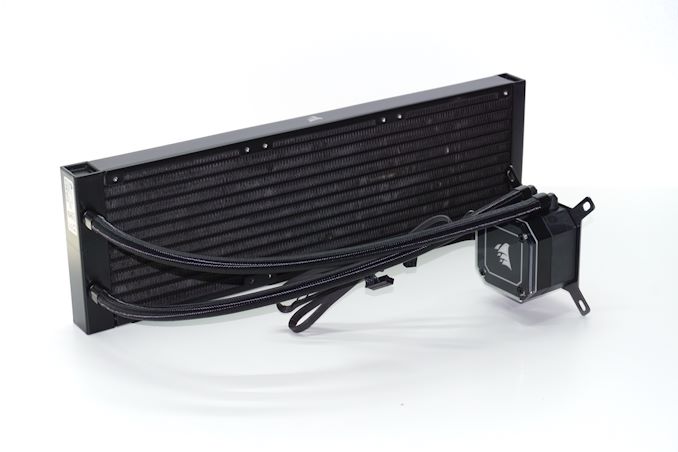
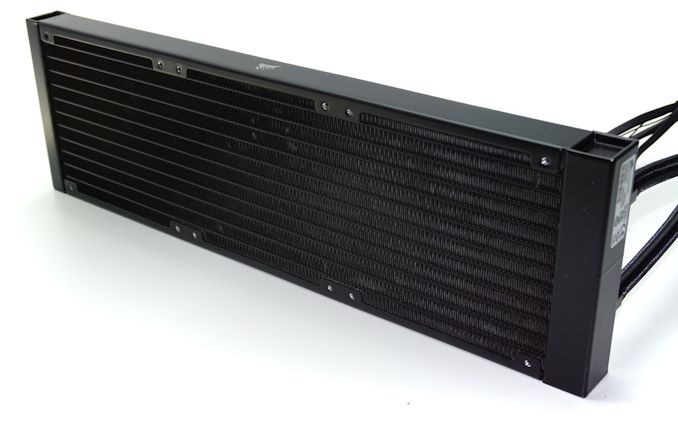
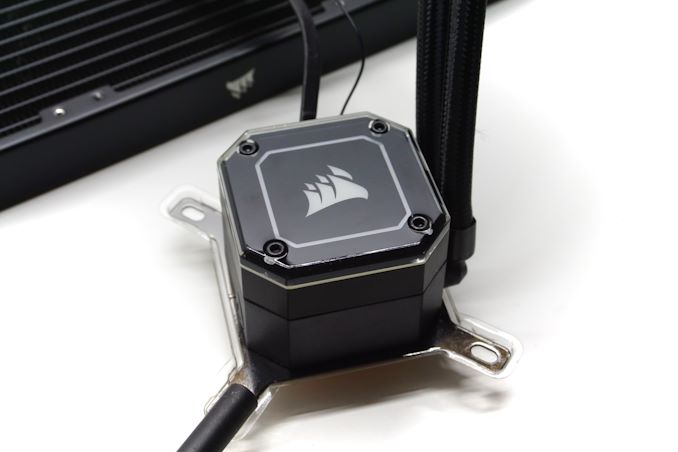
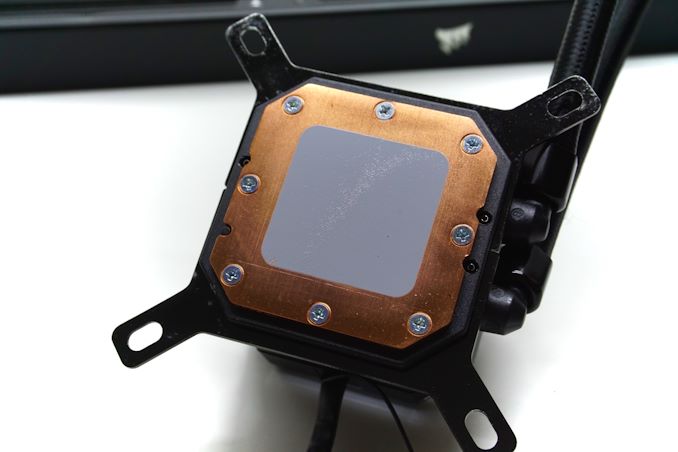
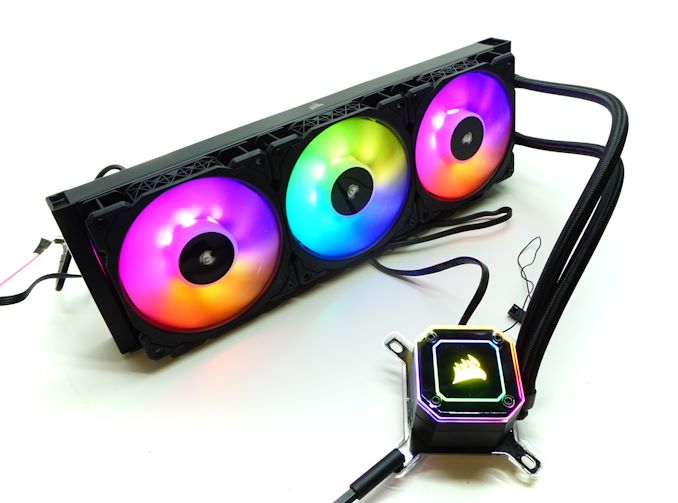





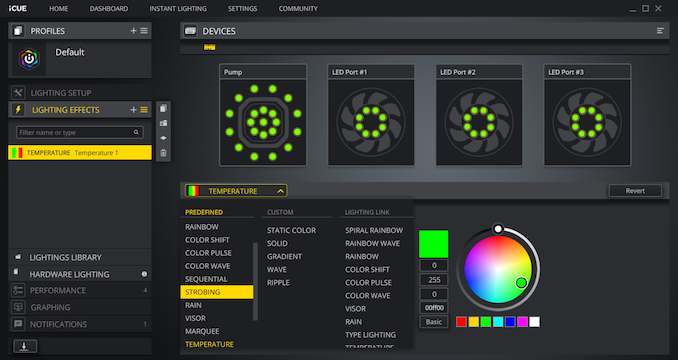








37 Comments
View All Comments
SirMaster - Sunday, October 25, 2020 - link
I mean my air cooled PC fans are never faster than 800rpm. I can't even tell if it's on or off from a few feet away.khanikun - Sunday, October 18, 2020 - link
A whisper is around 30 db. NZXT Kraken X63 280mm in reviews is around 30 db at low. So I'd say that's whisper quiet.willis936 - Thursday, October 15, 2020 - link
Not even Corsair's marketing speaks so highly about these fans. Magnetic bearings are not "magnetic levitation engines" (that would be the motor, which all fans have) and they are not new.They're awesome and they're cool to see in case fans, but the 1st page words leave a bad taste.
https://en.wikipedia.org/wiki/Magnetic_bearing
https://www.corsair.com/corsairmedia/sys_master/pr...
E.Fyll - Thursday, October 15, 2020 - link
From my point of view, the magnetic bearing is but a part of the engine that converts electrical energy to mechanical energy (airflow). You are probably referring to the engine as just the part that converts electrical energy to torque, neglecting the rest of the transmission system, which is not wrong but I would rather keep things simpler than that in my texts. I always classify fan engines based on their movement transmission system because everything else remains pretty much the same. You will find terms such as "ball-bearing engine" and "sleeve-bearing engine" frequently in my texts. The term "magnetic levitation engine" may not be entirely technically correct but definitely is better than "a 12V DC brushless motor with a magnetic levitation bearing axial transmission system" for the average person.Magnetic bearings may not be new by technological terms but they are just finding applications in low-cost retail market products, hence they are cutting-edge by the applicable definition of the term. There are many technologies that find their way into the retail market many decades after their initial discovery - that does not make them archaic, it only means that the conditions made their commercial exploitation applicable.
willis936 - Thursday, October 15, 2020 - link
These are fair points. Thanks for taking the time to respond.Pneumothorax - Thursday, October 15, 2020 - link
I’m currently running a NH-D15 on a 9900K. Am I getting any improvement with this besides just the aesthetics?Drkrieger01 - Thursday, October 15, 2020 - link
No. You'll may actually lose cooling capacity, as Linus found out (Linus Tech Tips). He did a review showing that big heatsinks like the Noctua NH-D15 outperform pretty much all AIO water coolers when it comes to heat soak (when the heatsink/radiator hit their dissipation limits). Granted, the margin is only a few degrees, but still. What you will get with an AIO water cooler is a slower increase/decrease in temperatures as the water works as an absorbing/transfer medium. The more water in the loop, the longer it takes to bring up the temperatures.Drkrieger01 - Thursday, October 15, 2020 - link
I should also say that, if AIO coolers would actually use a copper radiator, they would outperform something like the NH-D15. None of the AIO's use copper in their radiator, and I believe this is due to a patent being held by the main AIO manufacturer.imaheadcase - Thursday, October 15, 2020 - link
I don't think that would matter though, it still follows tubing back to the CPU, that itself is terrible at temp retention. Especially when they make them long on purpose for all case types they installed in.But yah i found its to much of a hassle to go all out with stuff like this, really AIO coolers for me now are just about looking better and working better in case for airflow than actual performance.
imaheadcase - Thursday, October 15, 2020 - link
on side note pet peeve, for whatever reason EVERY AIO cooler i have bought has never fit correctly in a case i've had..despite it showing it should before i bought it. Its mostly cosmetic things to change, like bending a small piece of metal, or something you won't notice with case cover on. But last one was a pain because after everything was installed in complete new build..it wouldn't power on. So did the normal check everything is connected, yep. I ended up finding out that radiator actually cut the USB cable connection front of case next to power button. So it was shorting out, all i had to do was unplug usb and booted up fine.That litte stupid problem would of been avoided if had correct specs..that was like 2 hours of trouble shooting. lol